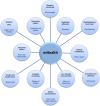Opportunities in the cloud or pie in the sky? Current status and future perspectives of telemedicine in nephrology
- PMID: 33619442
- PMCID: PMC7454484
- DOI: 10.1093/ckj/sfaa103
Opportunities in the cloud or pie in the sky? Current status and future perspectives of telemedicine in nephrology
Abstract
The use of telehealth to support, enhance or substitute traditional methods of delivering healthcare is becoming increasingly common in many specialties, such as stroke care, radiology and oncology. There is reason to believe that this approach remains underutilized within nephrology, which is somewhat surprising given the fact that nephrologists have always driven technological change in developing dialysis technology. Despite the obvious benefits that telehealth may provide, robust evidence remains lacking and many of the studies are anecdotal, limited to small numbers or without conclusive proof of benefit. More worryingly, quite a few studies report unexpected obstacles, pitfalls or patient dissatisfaction. However, with increasing global threats such as climate change and infectious disease, a change in approach to delivery of healthcare is needed. The current pandemic with coronavirus disease 2019 (COVID-19) has prompted the renal community to embrace telehealth to an unprecedented extent and at speed. In that sense the pandemic has already served as a disruptor, changed clinical practice and shown immense transformative potential. Here, we provide an update on current evidence and use of telehealth within various areas of nephrology globally, including the fields of dialysis, inpatient care, virtual consultation and patient empowerment. We also provide a brief primer on the use of artificial intelligence in this context and speculate about future implications. We also highlight legal aspects and pitfalls and discuss the 'digital divide' as a key concept that healthcare providers need to be mindful of when providing telemedicine-based approaches. Finally, we briefly discuss the immediate use of telenephrology at the onset of the COVID-19 pandemic. We hope to provide clinical nephrologists with an overview of what is currently available, as well as a glimpse into what may be expected in the future.
Keywords: CKD; ESRD; dialysis; quality of life; systematic review; technology; telemedicine; virtual consultation.
© The Author(s) 2020. Published by Oxford University Press on behalf of ERA-EDTA.
Figures







References
-
- Hailey D. Telehealth in nephrology care 2014: Promises and challenges. Am J Kidney Dis 2016; 68: 5–7 - PubMed
-
- Horton R. Offline: extinction or rebellion? Lancet 2019; 394: 1216. - PubMed
-
- Korevaar JC, Feith GW, Dekker FW et al. Effect of starting with hemodialysis compared with peritoneal dialysis in patients new on dialysis treatment: a randomized controlled trial. Kidney Int 2003; 64: 2222–2228 - PubMed
Publication types
LinkOut - more resources
Full Text Sources

